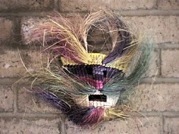Masks


Masks



Introduction

One of the first ways in which primitive man expressed his artistic instincts was by making masks. We don't know who make the first masks or even when or why. Some people believe men wore masks to disguise themselves while hunting. Others think primitive people made masks to frighten their enemy on the battlefield.
Over time, masks have been used for many purposes. They have been used to disguise, like the red lion mask used in the lion dance of China and Japan, and the masks worn as part of African tribal dance, and of course, in our own Halloween celebrations. In religious rituals they have been used to insure a good harvest or a safe hunt or to ward off evil. Some cultures believe that the person wearing a mask is transformed into the character of the mask. The great bird masks of the Pacific Northwest Indians are supposed to change their wearers into the fierce spirits of the birds they represent. Masks sometimes memorialize the dead. The mummy of Egypt's King Tutankhamen was adorned with an elaborate golden mask. In New Guinea people create masks for themselves. After a person dies, his spirit is perpetuated by someone else wearing his mask.
Over four thousand years ago the early Chinese made terrifying and ferocious clay masks with bristling fangs and gaping mouths which represented demons and monsters, creatures of the spirit world.

Masks came to be used in theater because drama grew out of primitive ceremonies that incorporated masks. The earliest dramatic use of masks that we know about was in Greece. Masked singers and dancers represented the gods, satyrs, and other mythical beings. Their exaggerated expressions could be seen by the audience in the large open air theaters. Small megaphones were even sometimes hidden in these masks.
Half masks, covering the eyes and nose were used by Italian clowns in the 1500's. They are still seen at masquerade parties and costume balls. They were also enjoyed in baroque theater and dance during the 1600's and 1700's.
Masks can represent the whole range of human emotion. They can be scary, happy, bawdy or jolly. They are part of many cultures, and are products of their maker's imaginations, beliefs and needs.
When working with masks with young children, it is very important not to bring in scary or grotesque masks. We do want to share an exciting collection of masks from around the world with the children, and to talk with them about their uses in other cultures. Show them that masks have been made from many different materials, and relate the masks to geography. Point out the origin of masks in your collection on the globe or maps. Older children might try to copy a mask from another country.
The web site http://www.masks.org contains a superb collection of masks, and a some related cultural information.
